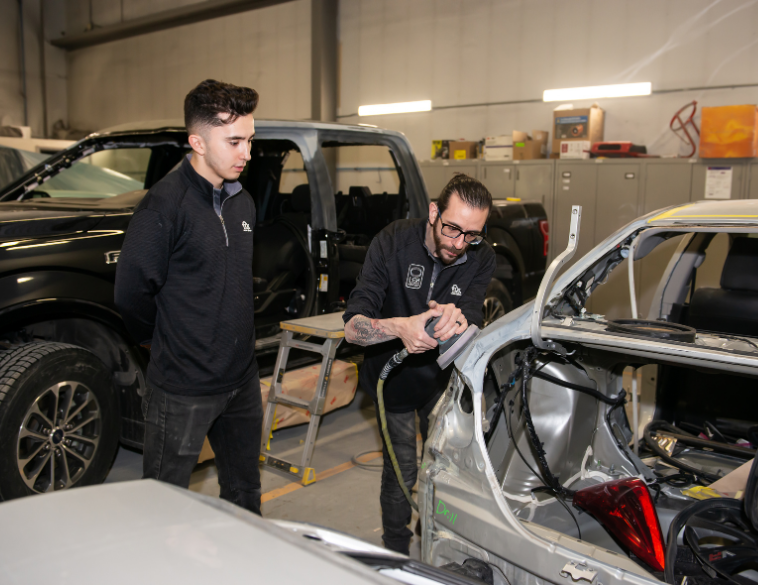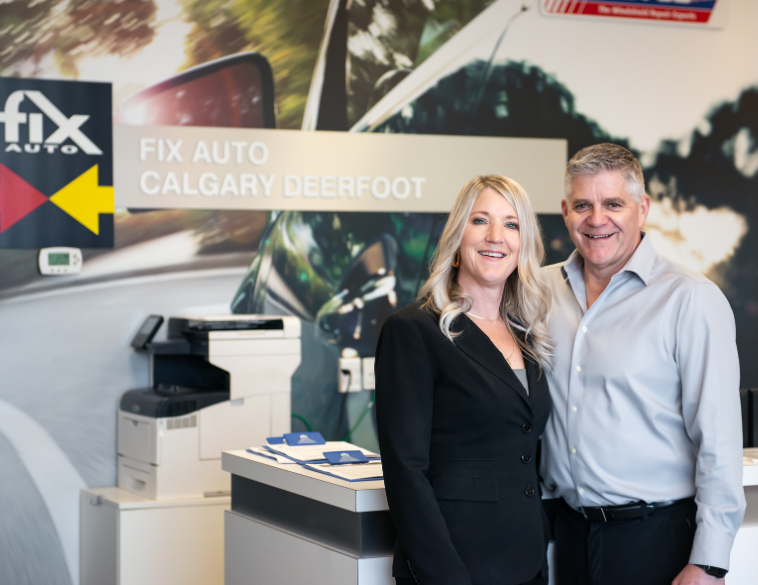Fix Auto Calgary Deerfoot emphasizes the importance of technical proficiency and skills development in today’s collision repair industry.
Fix Auto Calgary Deerfoot, a modern, expansive facility located near Calgary International Airport, is operated by Andy and Lana Moritz. It is one of four locations owned and operated by Andy and Lana – the others comprising Fix Auto Drayton Valley, Fix Auto Strathmore, and NOVUS Glass Deerfoot.
Involved in the collision repair industry since 2009, the Moritzes has worked hard building a multi-shop operation that provides state-of-the-art collision repairs, ADAS calibrations, wheel alignments, paintless dent repair and full-service windshield repair and replacement.
Certified repair facility
Fix Auto Calgary Deerfoot is a Certified Collision Care facility, meaning it is recognized as certified for repairing Chrysler, Dodge, Fiat, Jeep, Ram, Hyundai, Kia and Nissan vehicles. It is also a certified General Motors location for repairs to Buick, Cadillac, Chevrolet and GMC cars, trucks and SUVs.
For Andy and Lana, a big focus of their business is training and development, which has not only led to OEM certifications, but also a high level of proficiency among their staff and technicians. Yet achieving this is not without its challenges, especially in the modern collision repair environment.
One of the biggest is the rapid advancement of vehicle technology. “It’s changing so quickly it can be difficult to stay ahead of it,” Lana explains. The second issue facing many shops today concerns the time and money required to stay on top of training. “Technicians must put a considerable amount of time into the training, and the costs to stay certified are becoming more and more expensive,” says Lana.
Another factor is that technicians are expected to learn after-hours on their own time in many cases, which eats into both their personal lives and productivity.

Training centre investment
Providing effective training to its franchise partners is a key driver for Fix Network in Canada. It’s one of the reasons why the global network has invested in dedicated training centres in Calgary, Blainville, Quebec, and in Milton, Ontario.
Given their approach to collision repair and their emphasis on staff training and development, the Moritzes are very excited for the potential a local Fix Network Training Centre provides businesses like theirs.
“The Fix Training Centre will be a very valuable resource for the shop network by training new technicians to the high standards Fix Network has for repairs, as well as attracting and retaining talent in a cost-effective manner,” Lana explains. “We will stand out as an employer of choice [in our community] that invests in its people.”
Yet to be truly successful, collision centres within the Fix Network need to continue focusing on their own initiatives to benefit from resources such as a corporate training centre. This becomes particularly important in today’s environment, given the growing complexity of traditional vehicles. Additionally, the current focus on battery electric cars and trucks requires a different approach to collision repair.
Additional considerations
Because EVs are a new concept for many shops, this presents additional challenges. “EVs are a good example of the need to change the way we do repairs,” Lana explains. She notes that not only does this increase costs for the shop but it also “increases the expectations on our technicians to do these repairs.”
Another concern is that because EVs are still currently a niche product, repair information and training courses aren’t always readily available, meaning additional time and resources are required to research and obtain the right repair information and learn the required techniques.
This impacts both repair procedures and cycle time, adding costs and complexity for the collision centre. It’s the reason why both the shops and networks they’re aligned with can really benefit from working together on training and development initiatives.
Given how quickly technology is changing, the Moritzes recognize that going forward, a greater specialization of repair skills is essential if collision centres are going to stay ahead of the curve.
Pipeline of talent
While supporting current staff and technicians is critical, so is the need to ensure there is a pipeline of talent for the future. Progressive collision-repair centres like Fix Auto Calgary Deerfoot see working directly with trade schools as a way to refer apprentices to their business. “This keeps new technicians employed in our system and continues the trade in our markets,” says Lana.
Yet attracting and keeping apprentices requires a multi-pronged approach. And it starts with education. “This is absolutely necessary to attract good talent,” Lana explains.
She notes that awareness is the objective in illustrating what a dynamic and rewarding career collision repair can be. That means getting in front of trade schools and participating in Registered Apprenticeship Repair Programs in high schools.
The Moritzes also actively encourage young people to come and spend a few days in the shop environment to get a feel for what it’s all about, as well as providing them with the opportunity to learn.
“Autobody repair and painting can be a very rewarding career with high income potential,” says Lana, “and [as an industry,] we don’t say enough about how great it is. Ultimately, it’s up to all of us to promote our tradespeople and engage new recruits to join us.”




